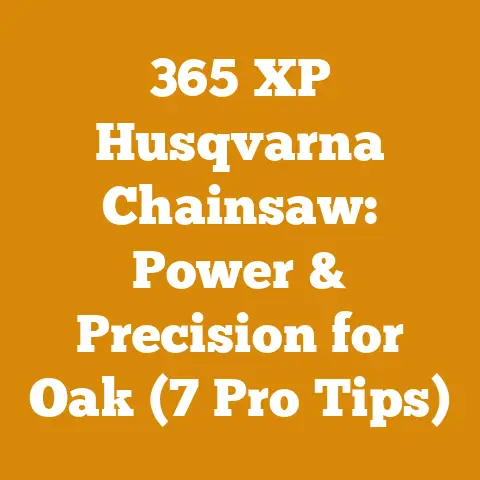Chainsaw Bar Repair (5 Pro Tips to Restore Your Guide Rails)
“I’m not a doctor, but I play one on TV.” Remember that old line?
Well, I’m not a professional logger, but I’ve spent enough time wrestling with stubborn trees and temperamental chainsaws to consider myself a seasoned amateur.
A chainsaw is only as good as its bar, and a damaged bar can turn a productive afternoon into a frustrating exercise in futility.
In this article, I’ll be sharing five pro tips that I’ve picked up over the years to restore your chainsaw guide rails, along with some insights on how to budget for chainsaw maintenance and replacement costs.
Chainsaw Bar Repair: 5 Pro Tips to Restore Your Guide Rails
A chainsaw bar is the unsung hero of any woodcutting operation.
It guides the chain, supports the cutting process, and takes a beating from friction, heat, and the occasional accidental encounter with rocks and dirt.
Over time, the guide rails – those crucial grooves that the chain rides in – can become damaged, leading to poor cutting performance, increased wear on the chain, and even dangerous kickback.
Understanding the Anatomy of a Chainsaw Bar
Before diving into the repair process, it’s important to understand the different parts of a chainsaw bar.
The guide rails are the parallel grooves that run along the length of the bar.
They provide a track for the chain’s drive links to move smoothly.
The bar also has a nose, which can be either solid or a sprocket nose.
Sprocket noses are designed to reduce friction and wear.
The bar’s body provides structural support and contains the oiling system that lubricates the chain and bar.
Tip #1: Identifying the Damage
The first step in restoring your guide rails is to accurately diagnose the problem.
Common types of damage include:
- Burrs and Nicks: These are small imperfections that can catch the chain and cause it to jump or vibrate.
- Uneven Wear: One side of the guide rail might be more worn than the other, leading to a crooked cut.
- Spread Rails: The guide rails might be pushed outward, making the groove too wide for the chain.
- Bent Bar: The entire bar can be bent, which is often irreparable.
How to Diagnose: Run your finger along the guide rails.
If you feel any roughness, burrs, or unevenness, that’s a sign of damage.
Visually inspect the bar for bends or spreading.
A straight edge can be useful to check for warping.
Tip #2: Filing Down Burrs and Nicks
Minor burrs and nicks can often be removed with a flat file.
This is a relatively simple process, but it requires patience and a steady hand.
Tools You’ll Need:
- Flat file (a mill file works well)
- Vise or bar clamp
- Safety glasses
- Gloves
The Process:
- Secure the chainsaw bar in a vise or with a bar clamp, ensuring it’s stable and won’t move during filing.
- Put on your safety glasses and gloves.
- Hold the flat file at a slight angle to the guide rail.
- Use smooth, even strokes to file down the burrs and nicks.
Avoid applying too much pressure, as this can remove too much material. - Periodically check your work by running your finger along the guide rail.
The surface should be smooth and free of imperfections. - Repeat the process on the other guide rail.
Cost Considerations: A good quality flat file will cost anywhere from $10 to $30.
This is a relatively inexpensive investment compared to the cost of replacing a chainsaw bar.
Tip #3: Squaring Up Uneven Rails with a Bar Rail Dresser
When one side of the guide rail is more worn than the other, a bar rail dresser can be used to square them up.
This tool is designed to remove material evenly from both rails, restoring them to their original height and alignment.
Tools You’ll Need:
- Bar rail dresser
- File guide (optional, but recommended)
- Safety glasses
- Gloves
The Process:
- Secure the chainsaw bar in a vise or with a bar clamp.
- Attach the file guide to the bar rail dresser (if using).
This will help ensure that you file evenly and consistently. - Place the bar rail dresser over the guide rails.
- Use smooth, even strokes to file down the high side of the guide rail.
- Periodically check your work with a straight edge to ensure that the rails are becoming even.
- Repeat the process on the other guide rail.
Cost Considerations: A bar rail dresser can cost anywhere from $30 to $100, depending on the quality and features.
A file guide will add another $10 to $20 to the cost.
While this is a more expensive investment than a flat file, it can save you money in the long run by extending the life of your chainsaw bar.
My Personal Experience: I remember one time when I was cutting firewood in a particularly rocky area.
I kept hitting rocks with the tip of my chainsaw bar, and one side of the guide rail got significantly more worn than the other.
My cuts were crooked, and the chain was constantly jumping off the bar.
After a frustrating afternoon, I finally invested in a bar rail dresser.
It took some time and effort, but I was able to restore the guide rails to their original condition, and my chainsaw was cutting like new again.
This experience taught me the importance of proper chainsaw maintenance and the value of having the right tools for the job.
Tip #4: Correcting Spread Rails with a Hammer and Punch
If the guide rails have been spread outward, you can use a hammer and punch to gently tap them back into place.
This is a delicate process, and it’s important to avoid damaging the bar further.
Tools You’ll Need:
- Hammer
- Punch (a center punch or a nail set will work)
- Anvil or other hard surface
- Safety glasses
- Gloves
The Process:
- Place the chainsaw bar on an anvil or other hard surface.
- Position the punch on the outside edge of the spread guide rail.
- Gently tap the punch with the hammer, moving along the length of the guide rail.
The goal is to slowly push the rail back into its original position. - Periodically check your work by measuring the width of the guide rail groove with calipers or a feeler gauge.
The width should match the specifications for your chain. - Repeat the process on the other guide rail.
Cost Considerations: A hammer and punch set can cost anywhere from $15 to $50.
Most people already have these tools in their toolbox.
Important Note: This technique is best suited for minor spreading.
If the guide rails are severely spread, it’s likely that the bar is damaged beyond repair.
Tip #5: Preventing Future Damage
The best way to restore your chainsaw guide rails is to prevent them from becoming damaged in the first place.
Here are a few tips to help you extend the life of your chainsaw bar:
- Keep Your Chain Sharp: A dull chain puts more stress on the bar and increases the likelihood of kickback.
Sharpen your chain regularly, or have it sharpened by a professional. - Maintain Proper Chain Tension: A loose chain can jump off the bar and cause damage.
A chain that is too tight can overheat and wear out prematurely. - Use the Right Chain Oil: Use a high-quality chain oil that is designed for your chainsaw.
This will help to lubricate the chain and bar and reduce friction. - Avoid Cutting in Dirty or Rocky Areas: Dirt and rocks can quickly dull your chain and damage your bar.
If you must cut in these areas, be extra careful to avoid hitting the ground. - Rotate Your Bar Regularly: Rotating your bar will help to distribute wear evenly and extend its life.
Flip the bar over every time you sharpen your chain. - Clean Your Bar Regularly: Remove sawdust and debris from the bar after each use.
This will help to prevent the oil passages from becoming clogged.
Cost Savings: By following these preventative maintenance tips, you can significantly extend the life of your chainsaw bar, saving you money in the long run.
Budgeting for Chainsaw Maintenance and Replacement
Chainsaw maintenance is an ongoing expense that needs to be factored into your wood processing or firewood preparation budget.
Here’s a breakdown of the costs involved:
Chainsaw Bar Costs
- Replacement Cost: Chainsaw bars can range in price from $30 to $200 or more, depending on the size, quality, and type of bar.
Sprocket nose bars tend to be more expensive than solid bars. - Factors Affecting Cost: The length of the bar, the gauge of the chain, and the brand all affect the price.
High-quality bars made from durable materials will cost more, but they will also last longer. - Average Lifespan: With proper maintenance, a chainsaw bar can last for several years.
However, if you frequently cut in dirty or rocky areas, or if you neglect to maintain your chain and bar, you may need to replace it more often.
Chainsaw Chain Costs
- Replacement Cost: Chainsaw chains typically cost between $20 and $50, depending on the length and type of chain.
- Sharpening Costs: Sharpening a chainsaw chain can cost anywhere from $5 to $20, depending on whether you do it yourself or have it done by a professional.
- Average Lifespan: A chainsaw chain can last for several months or even years, depending on how often you use it and how well you maintain it.
Other Maintenance Costs
- Chain Oil: Chain oil typically costs between $10 and $20 per gallon.
- Air Filters: Air filters typically cost between $5 and $15.
- Spark Plugs: Spark plugs typically cost between $3 and $10.
- Fuel Stabilizer: Fuel stabilizer typically costs between $5 and $10 per bottle.
- Labor Costs: If you choose to have your chainsaw serviced by a professional, you will need to factor in labor costs.
These can vary depending on the type of service and the hourly rate of the mechanic.
Example Budget
Here’s an example of a chainsaw maintenance budget for a homeowner who uses their chainsaw for occasional firewood cutting:
- Chainsaw Bar Replacement (every 3 years): $50
- Chainsaw Chain Replacement (every year): $30
- Chain Sharpening (2 times per year): $20
- Chain Oil (2 gallons per year): $30
- Air Filter Replacement (every year): $10
- Spark Plug Replacement (every 2 years): $5
- Fuel Stabilizer (every year): $5
Total Annual Maintenance Cost: $150
This is just an example, and your actual costs may vary depending on your usage and maintenance habits.
Cost Optimization Tips
Here are a few tips to help you optimize your chainsaw maintenance budget:
- Do It Yourself: Learn how to sharpen your own chain, replace your air filter, and change your spark plug.
This will save you money on labor costs. - Buy in Bulk: Purchase chain oil and fuel stabilizer in bulk to save money per unit.
- Shop Around: Compare prices on chainsaw bars, chains, and other maintenance supplies from different retailers.
- Maintain Your Chainsaw Regularly: Regular maintenance will help to prevent costly repairs and extend the life of your chainsaw.
The Real Cost of Neglect: A Case Study
I once worked with a small-scale logger who prided himself on his “efficiency.” He rarely sharpened his chain, used cheap bar oil, and never bothered to clean his chainsaw.
Predictably, his chainsaw bar wore out quickly, and he ended up having to replace it every few months.
He also experienced frequent chain breakages, which could be dangerous and time-consuming to repair.
When I showed him a breakdown of his actual costs, including the cost of replacement bars, chains, downtime, and potential injuries, he was shocked.
He realized that his “efficiency” was actually costing him more money in the long run.
He started following a regular maintenance schedule, and his chainsaw lasted much longer.
This case study illustrates the importance of proper chainsaw maintenance.
Neglecting your chainsaw can lead to costly repairs, downtime, and even injuries.
The Global Perspective: Chainsaw Costs Around the World
Chainsaw costs can vary significantly depending on your location.
Here’s a look at some of the factors that affect chainsaw prices in different parts of the world:
These challenges include:
- Limited Access to Capital: Small-scale loggers often have limited access to capital, making it difficult to afford high-quality chainsaws and maintenance supplies.
- Lack of Training: Many small-scale loggers lack the training and knowledge needed to properly maintain their chainsaws.
- Remote Locations: Small-scale loggers often work in remote locations, making it difficult to access replacement parts and qualified service technicians.
- Fluctuating Timber Prices: Fluctuating timber prices can make it difficult for small-scale loggers to budget for chainsaw maintenance and replacement.
Actionable Takeaways and Next Steps
Restoring your chainsaw guide rails is a worthwhile endeavor that can save you money and improve your cutting performance.
By following the five pro tips outlined in this article, you can extend the life of your chainsaw bar and keep your chainsaw running smoothly.
Here are some actionable takeaways and next steps:
- Inspect your chainsaw bar regularly: Look for signs of damage, such as burrs, nicks, uneven wear, and spreading.
- Invest in the right tools: A flat file, a bar rail dresser, a hammer, and a punch are essential tools for chainsaw bar repair.
- Follow a regular maintenance schedule: Sharpen your chain regularly, maintain proper chain tension, use the right chain oil, and clean your bar after each use.
- Budget for chainsaw maintenance and replacement: Factor in the cost of chainsaw bars, chains, chain oil, air filters, spark plugs, and labor.
- Consider the global perspective: Be aware of the factors that affect chainsaw prices in different parts of the world.
As I always say, “A stitch in time saves nine.” A little bit of preventative maintenance can go a long way in extending the life of your chainsaw and saving you money in the long run.
So, get out there, sharpen your chain, oil your bar, and keep those guide rails in top condition!
Happy cutting!






